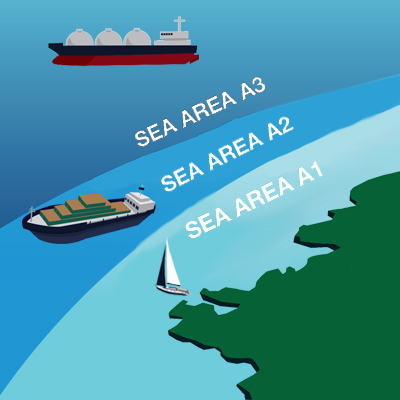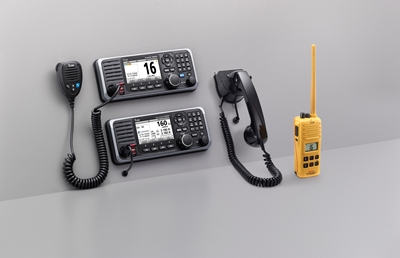Overview of GMDSS Sea Areas and Radio Safety Equipment Requirements

Large commercial vessels cover thousands of nautical miles, travelling through international waters whilst at sea for months at a time either delivering cargo or providing important services. If the worst was to happen and a ship needed rescue and support, they must use an internationally accepted safety system that can alert nearby sea search and rescue teams of their situation anywhere in the world. This is called Global Maritime Distress and Safety System (GMDSS).
GMDSS is an internationally agreed radio safety system and communication protocol for ships mandated by the International Maritime Organisation (IMO). GMDSS certified equipment is used to increase safety and make it easier to rescue distressed commercial ships by having one certified safety system. Ships engaged in international shipping (SOLAS vessels) are obliged to carry GMDSS certified communication equipment. GMDSS specifies that certain radios can only be used in relation to a ships area of operation and this guide has been put together to explain sea areas A1, A2, A3 & A4 and what type of radios can be used there.
GMDSS Sea Areas:
Sea Area A1:
This area is within coverage of VHF coast stations where digital selective calling alert (DSC) is available (CH. 70/156.525 MHz) so you must use VHF capable transceivers with DSC capabilities. Typically, this area could extend 30 to 40 nautical miles (56 to 74 km) from a coastal radio station.
Sea Area A2:
This excludes Sea Area A1 and provides coverage of at least one MF coast station and continuous DSC (2187.5kHz) alerting is available so a VHF and MF radio station set up is required. This area typically extends up to 180 nautical miles (330 km) offshore during daylight hours and 150 nautical miles (280 km) offshore during night time hours.
Sea Area A3:
Excluding Sea Areas A1 & A2, this area is within coverage of INMARSAT geostationary satellites. Here a complete VHF radio and either a MF/HF radio or INMARSAT station is required. This area covers 70-degrees North Latitude and 70-degrees South Latitude.
Sea Area A4:
This area excludes Sea Area’s A1, A2 & A3 and is essentially the polar regions. A complete VHF and MF/HF radio station must be used in this area. This covers 71-degrees North Latitude and above 71-degrees South Latitude.
Other Required Equipment:
Portable radios are also a necessity for all the sea areas mentioned above. 2 sets of 2-way radio for survival craft are necessary for cargo ships weighing 300-500 gross tons (GT) and 3 sets are necessary for all passenger ships as well as cargo ships weighing 500 GT or more.
As well as the portable radios, SOLAS vessels must also be equipped with a Search and Rescue Transponder (SART), a NAVETX (Navigational Telex) receiver, 406 MHz Emergency Position Indicating Radio Beacon (EPIRB) as well as an INMARSAT station.
What Icom Offer
Icom offer a full VHF and MF/HF solution that meets ITU Class A DSC requirements and complies with the
MED Ships "Wheelmark" and
UK "Red Ensign" Marine Equipment Regulations. The
GM600 VHF/DSC marine transceiver and Icom’s
GM800 GMDSS MF/HF radio provides a full GMDSS bridge radio line-up. Both radios provide loud, clear audio and feature large 4.3-inch colour LCD displays for clear visibility and a night mode feature for low light conditions.
Icom also offer the
IC-GM1600E Marine VHF handheld to complete our GMDSS range. The survival craft radio meets “Wheel Mark” MED certification, UK "Red Ensign" Marine Equipment Regulations as well as temperature, thermal shock, vibration and drop resistance (from 1m height) requirements. It also
meets international standards for life rafts and their emergency equipment.
You can also find more about the GM800, GM600 and the IC-GM1600E by downloading our latest GMDSS catalogue from the
‘Icom Catalogue’ section of our website.



